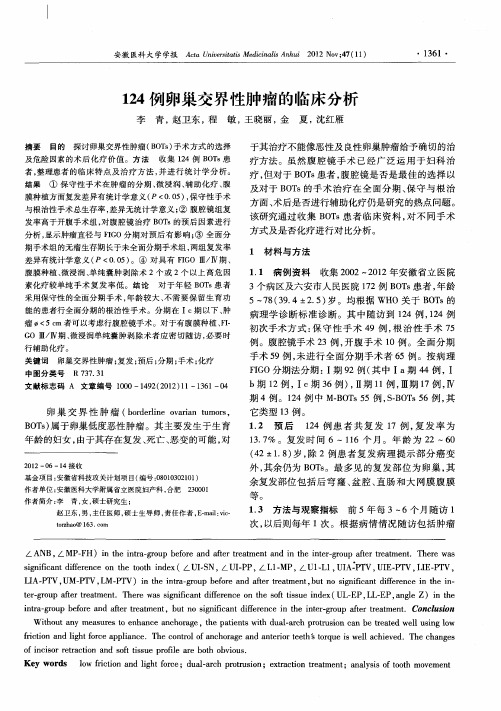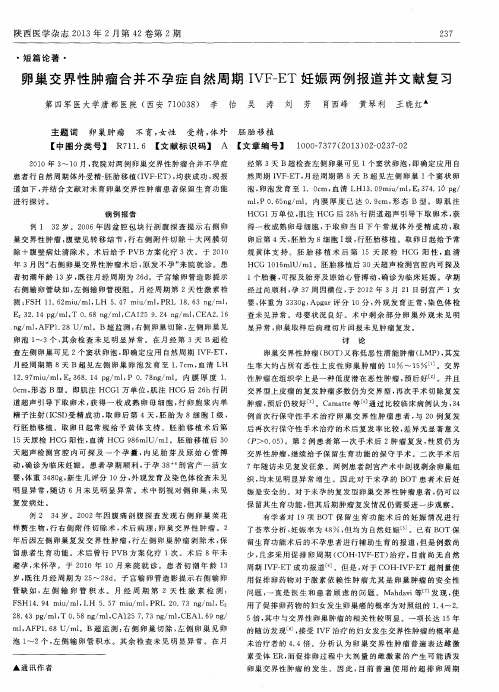卵巢交界性肿瘤保留生育功能术后妊娠与复发的临床分析
- 格式:pdf
- 大小:146.58 KB
- 文档页数:3


Ⅰ、Ⅱ期卵巢交界性肿瘤93例临床分析魏晚霞;黄美华;叶琳;王艺;李隆玉【摘要】目的:探讨Ⅰ、Ⅱ期卵巢交界性肿瘤( BOTs)的治疗方法及影响复发和预后的因素。
方法回顾性分析93例Ⅰ、Ⅱ期BOTs患者的临床资料。
结果Ⅰ期BOTs患者87例(93.5%),Ⅱ期6例(6.5%)。
病理类型以浆液性39例(41.9%)和黏液性肿瘤46例(49.5%)为主。
所有患者均行手术治疗,38例(40.9%)行保守性手术,55例(59.1%)行根治性手术。
93例中24例行术后辅助化疗,Ⅰ期22例,Ⅱ期2例。
93例中5例复发,复发率为5.4%,均为Ⅰ期行保守性手术且术后未行化疗的患者,平均复发时间为39.8个月(12~72个月),中位复发时间为36个月,无1例死亡。
结论Ⅰ、Ⅱ期BOTs 预后良好,手术是其主要的治疗手段,保守性手术治疗虽然会影响复发率,但不影响生存期;对有高危因素患者,术后短期内给予化疗,可减少复发,但不能改变患者预后。
%Objective To investigate the treatment forⅠandⅡborderline ovarian tumors ( BOTs) and influence fac-tors of recurrence and prognosis.Methods Clinical data of 93 cases ofⅠandⅡBOTs were retrospectively analyzed.Results 87 cases (93.5%) were stageⅠBOTs,6 cases (6.5%) were stageⅡBOTs.The pathological types were mainly serous 39 cases (41.9%)and mucinous tumors 46 cases (49.5%).Patients all underwent surgery,38 cases received conservative surgery (40.9%),55 cases(59.1%) received radical surgery.Among the 93 cases,24 cases received postoperative adjuvant chemother-apy,stageⅠwas 22 cases,stageⅡwas 2 cases.Among the 93 patients,there had 5 cases of recurrence,therecurr ence rate was 5.4%,these patients were stageⅠtreated withconservative surgery without postoperative chemotherapy,average recurrence time was 39.8 months (12~72 months),median time to recurrence was 36 months,with no deaths.Conclusion Stage Ⅰ and ⅡBOTs has good prognosis,and operation is the main treatment method,although conservative surgery affects the recurrence rate, but does not affect survival;patients with high risk factors should receive chemotherapy shortly after surgery,it can reduce the re-currence,but can not change the prognosis of patients.【期刊名称】《实用癌症杂志》【年(卷),期】2015(000)002【总页数】3页(P279-281)【关键词】Ⅰ;Ⅱ期卵巢交界性肿瘤;手术治疗;化学治疗;复发【作者】魏晚霞;黄美华;叶琳;王艺;李隆玉【作者单位】330006 江西省妇幼保健院;江西省吉安市新干县妇幼保健院;330006 江西省妇幼保健院;330006 江西省妇幼保健院;330006 江西省妇幼保健院【正文语种】中文【中图分类】R737.31【Abstract】Objective To investigate the treatment for Ⅰ and Ⅱ borderline ovarian tumors (BOTs) and influence factors of recurrence and prognosis.Methods Clinical data of 93 cases of Ⅰ and Ⅱ BOTs were retrospectively analyzed.Results 87 cases (93.5%) were stageⅠ BOTs,6cases (6.5%) were stageⅡ BOTs.The pathological types were mainly serous 39 cases(41.9%)and mucinous tumors 46 cases (49.5%).Patients all underwent surgery,38 cases received conservative surgery(40.9%),55cases(59.1%) received radical surgery.Among the 93 cases,24 cases received postoperative adjuvant chemotherapy,stage Ⅰ was 22 cases,stage Ⅱ was 2 cases.Among the 93 patients,there had 5 cases of recurrence,the recurrence rate was 5.4%,these patients were stage Ⅰ treated with conservative surgery without postoperative chemotherapy,average recurrence time was 39.8 months (12~72 months),median time to recurrence was 36 months,with no deaths.Conclusion Stage Ⅰ and Ⅱ BOTs has good prognosis,and operation is the main treatmentmethod,although conservative surgery affects the recurrence rate,but does not affect survival;patients with high risk factors should receive chemotherapy shortly after surgery,it can reduce the recurrence,but cannot change the prognosis of patients.【Key words】Ⅰ and Ⅱ borderline ovarian tumors;Surgery;Chemotherapy;Recurrence近年来关于卵巢交界性肿瘤(borderline ovarian tumors,BOTs)主要的争议多集中于其治疗,尤其是否辅助化疗[1]。




卵巢交界性肿瘤的保守治疗摘要本文对年轻的未生育的卵巢交界性肿瘤患者是否保留生育功能、保守治疗后的妊娠情况和复发情况及再次手术情况和随访情况进行了讨论。
结果表明,保守治疗虽然会增加复发率,但不影响生存期,且保留了生育功能,提高了生存质量。
关键词卵巢交界性肿瘤保留生育功能的手术复发妊娠卵巢交界性肿瘤(BOT),也称为“低度潜在恶性卵巢肿瘤”,是介于良性与恶性之间的一组具有不同组织学类型的上皮性病变,占所有卵巢上皮性肿瘤的10%~20%,发病年龄30~50岁,比卵巢恶性肿瘤的平均发病年龄早10年。
随着生育年龄的推迟,许多患者发病时并未完成生育。
1971年被FIGO列为卵巢肿瘤独立的临床和病理类型,1973年WHO命名为卵巢交界性恶性肿瘤,1999年WHO新分类为交界性肿瘤。
BOT常见病理类型包括卵巢交界性浆液性肿瘤(S-BOT)及卵巢交界性黏液性肿瘤(M-BOT),其他少见病理类型包括卵巢交界性透明细胞、子宫内膜样、移行细胞、混合型肿瘤,其中S-BOT约65%,M-BOT约32%。
BOT的病理组织学诊断标准主要以细胞增生层次、细胞的异型性和有无间质浸润为标准,其中有无间质浸润是鉴别癌与交界瘤的关键点。
BOT采取和卵巢癌一样FIGO临床分期标准[1],即:Ⅰ期:肿瘤局限于卵巢;Ⅱ期:肿瘤累及一侧或双侧卵巢伴有盆腔转移;Ⅲ期:肿瘤侵犯一侧或双侧卵巢,并有显微镜证实的盆腔外腹膜转移和(或)区域淋巴结转移;Ⅳ期:远处转移。
BOT大多数被诊断时是FIGO分期为Ⅰ期的早期肿瘤,预后也比卵巢癌好得多。
FIGO分期为Ⅰ~Ⅱ期的BOT患者10年生存率可达98%~99%,FIGO分期Ⅲ~Ⅳ期的患者生存率>75%[2],肿瘤的这一生物学特点为临床的处理提供了极大的机遇和选择治疗方式的可能性。
相比卵巢恶性肿瘤往往在晚期才被发现,50%~85%的卵巢交界性肿瘤被诊断时是FIGO分期为Ⅰ期的早期肿瘤。
BOT的临床表现:大部分BOT患者最常见的临床表现是无症状的附件区包块,早期无明显不适症状,常在体检时偶然发现。